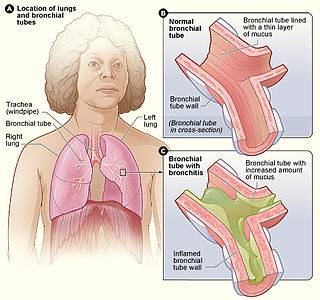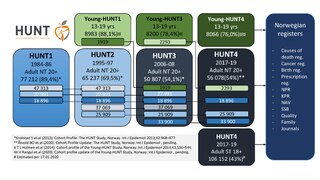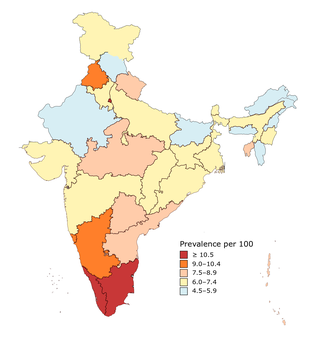Related Research Articles

Asthma is a long-term inflammatory disease of the airways of the lungs. It is characterized by variable and recurring symptoms, reversible airflow obstruction, and easily triggered bronchospasms. Symptoms include episodes of wheezing, coughing, chest tightness, and shortness of breath. These may occur a few times a day or a few times per week. Depending on the person, asthma symptoms may become worse at night or with exercise.

The Buteyko method or Buteyko Breathing Technique is a form of complementary or alternative physical therapy that proposes the use of breathing exercises primarily as a treatment for asthma and other respiratory conditions.
Lifestyle diseases can be defined as diseases linked with one's lifestyle. These diseases are non-communicable diseases. They are caused by lack of physical activity, unhealthy eating, alcohol, substance use disorders and smoking tobacco, which can lead to heart disease, stroke, obesity, type II diabetes and lung cancer. The diseases that appear to increase in frequency as countries become more industrialized and people live longer include Alzheimer's disease, arthritis, atherosclerosis, asthma, cancer, chronic liver disease or cirrhosis, chronic obstructive pulmonary disease, colitis, irritable bowel syndrome, type 2 diabetes, heart disease, hypertension, metabolic syndrome, chronic kidney failure, osteoporosis, PCOD, stroke, depression, obesity and vascular dementia.

Spirometry is the most common of the pulmonary function tests (PFTs). It measures lung function, specifically the amount (volume) and/or speed (flow) of air that can be inhaled and exhaled. Spirometry is helpful in assessing breathing patterns that identify conditions such as asthma, pulmonary fibrosis, cystic fibrosis, and COPD. It is also helpful as part of a system of health surveillance, in which breathing patterns are measured over time.
Disease management is defined as "a system of coordinated healthcare interventions and communications for populations with conditions in which patient self-care efforts are significant."

Non-invasive ventilation (NIV) is the use of breathing support administered through a face mask, nasal mask, or a helmet. Air, usually with added oxygen, is given through the mask under positive pressure; generally the amount of pressure is alternated depending on whether someone is breathing in or out. It is termed "non-invasive" because it is delivered with a mask that is tightly fitted to the face or around the head, but without a need for tracheal intubation. While there are similarities with regard to the interface, NIV is not the same as continuous positive airway pressure (CPAP), which applies a single level of positive airway pressure throughout the whole respiratory cycle; CPAP does not deliver ventilation but is occasionally used in conditions also treated with NIV.

Respiratory diseases, or lung diseases, are pathological conditions affecting the organs and tissues that make gas exchange difficult in air-breathing animals. They include conditions of the respiratory tract including the trachea, bronchi, bronchioles, alveoli, pleurae, pleural cavity, the nerves and muscles of respiration. Respiratory diseases range from mild and self-limiting, such as the common cold, influenza, and pharyngitis to life-threatening diseases such as bacterial pneumonia, pulmonary embolism, tuberculosis, acute asthma, lung cancer, and severe acute respiratory syndromes, such as COVID-19. Respiratory diseases can be classified in many different ways, including by the organ or tissue involved, by the type and pattern of associated signs and symptoms, or by the cause of the disease.
The Joondalup Family Health Study (JFHS) will be an extensively characterized, community-based cohort study, which will investigate the complex interplay of environmental, lifestyle and genetic components that affect the risk of common conditions such as asthma, heart disease and diabetes. The Study will take place in Joondalup, Western Australia and will have a strong focus on families and the health of both children and adults.

Bronchitis is inflammation of the bronchi in the lungs that causes coughing. Bronchitis usually begins as an infection in the nose, ears, throat, or sinuses. The infection then makes its way down to the bronchi. Symptoms include coughing up sputum, wheezing, shortness of breath, and chest pain. Bronchitis can be acute or chronic.

Obstructive lung disease is a category of respiratory disease characterized by airway obstruction. Many obstructive diseases of the lung result from narrowing (obstruction) of the smaller bronchi and larger bronchioles, often because of excessive contraction of the smooth muscle itself. It is generally characterized by inflamed and easily collapsible airways, obstruction to airflow, problems exhaling, and frequent medical clinic visits and hospitalizations. Types of obstructive lung disease include; asthma, bronchiectasis, bronchitis and chronic obstructive pulmonary disease (COPD). Although COPD shares similar characteristics with all other obstructive lung diseases, such as the signs of coughing and wheezing, they are distinct conditions in terms of disease onset, frequency of symptoms, and reversibility of airway obstruction. Cystic fibrosis is also sometimes included in obstructive pulmonary disease.
The Epidemiology Data Center (EDC) is recognized as an official University Center at the University of Pittsburgh; and is part of the Department of Epidemiology at the University of Pittsburgh Graduate School of Public Health. The EDC was formed in 1980 by Katherine M. Detre, M.D., Dr.P.H., and is currently under the co-direction of Maria Mori Brooks, Ph.D., Steven H. Belle, Ph.D. and Stephen R. Wisniewski, Ph.D.
Respiratory Health Association is a nonprofit organization located on Chicago's Near West Side.
Bronchial hyperresponsiveness is a state characterised by easily triggered bronchospasm.

The Firestone Institute for Respiratory Health (FIRH) is a center for the investigation and treatment of respiratory diseases. Based out of St. Joseph's Healthcare in Hamilton, Ontario, Canada, the institute is a clinical facility with strong research directions. FIRH faculty are also heavily involved at McMaster University with education at the undergraduate, graduate, post-graduate and continuing medical education levels.
The Healthcare Quality Improvement Partnership (HQIP) was established in April 2008 to promote improvement in health services, by increasing the impact that clinical audit has on healthcare quality in England and Wales and, in some cases other devolved nations. It is led by a consortium of the Academy of Medical Royal Colleges, Royal College of Nursing and National Voices.

Chronic obstructive pulmonary disease (COPD) is a type of progressive lung disease characterized by long-term respiratory symptoms and airflow limitation. The main symptoms of COPD include shortness of breath and a cough, which may or may not produce mucus. COPD progressively worsens, with everyday activities such as walking or dressing becoming difficult. While COPD is incurable, it is preventable and treatable. The two most common types of COPD are emphysema and chronic bronchitis and have been the two classic COPD phenotypes. Emphysema is defined as enlarged airspaces (alveoli) whose walls have broken down resulting in permanent damage to the lung tissue. Chronic bronchitis is defined as a productive cough that is present for at least three months each year for two years. Both of these conditions can exist without airflow limitation when they are not classed as COPD. Emphysema is just one of the structural abnormalities that can limit airflow and can exist without airflow limitation in a significant number of people. Chronic bronchitis does not always result in airflow limitation but in young adults who smoke the risk of developing COPD is high. Many definitions of COPD in the past included emphysema and chronic bronchitis, but these have never been included in GOLD report definitions. Emphysema and chronic bronchitis remain the predominant phenotypes of COPD but there is often overlap between them and a number of other phenotypes have also been described. COPD and asthma may coexist and converge in some individuals. COPD is associated with low-grade systemic inflammation.

The Trøndelag Health Study is a cohort health study performed in the Norwegian county of Trøndelag. HUNT is considered one of the most extensive cohort studies ever conducted in any country. The HUNT Research Centre, which is responsible for collecting and providing access to the data and samples from the study, is part of the Faculty of Medicine and Health Sciences at the Norwegian University of Science and Technology (NTNU).
The Dutch hypothesis provides one of several biologically plausible explanations for the pathogenesis of chronic obstructive pulmonary disease (COPD), a progressive disease known to be aetiologically linked to environmental insults such as tobacco smoke.

India has an estimated 77 million people formally diagnosed with diabetes, which makes it the second most affected in the world, after China. Furthermore, 700,000 Indians died of diabetes, hyperglycemia, kidney disease or other complications of diabetes in 2020. One in six people (17%) in the world with diabetes is from India. The number is projected to grow by 2045 to become 134 million per the International Diabetes Federation.
Peter Burney is a British epidemiologist. He is emeritus professor of respiratory epidemiology and public health at the National Heart and Lung Institute, Imperial College London. He is a Fellow of the Academy of Medical Sciences since 2001.
References
- ↑ "Research Publications". Busselton Population Medical Research Institute. 2 May 2014. Retrieved 28 July 2019.
- ↑ "Key Projects & studies: Busselton Health Study". Busselton Population Medical Research Institute. 13 May 2014. Retrieved 28 July 2019.
- ↑ "History". Busselton Population Medical Research Institute. 2 May 2014. Retrieved 30 July 2019.
- ↑ "Busselton Health Study". University of Western Australia. Retrieved 30 July 2019.
- ↑ "Newsletter Vol 1 Issue 1" (PDF). Busselton Population Medical Research Foundation. October 2004. Retrieved 30 July 2019.
- ↑ Daniels SE, Bhattacharrya S, James A, et al. (1996). "A genome-wide search for quantitative trait loci underlying asthma". Nature. 383 (6597): 247–50. Bibcode:1996Natur.383..247D. doi:10.1038/383247a0. PMID 8805698. S2CID 22256638.
- ↑ Olynyk J, Cullen D, Aquilia S, Rossi E, Summerville L, Powell L (1999). "A population-based study of the clinical expression of the hemochromatosis gene" (PDF). New England Journal of Medicine. 341 (10): 718–24. doi:10.1056/NEJM199909023411002. PMID 10471457.
- 1 2 3 4 5 6 7 8 9 10 "Past projects". Busselton Population Medical Research Institute. 14 May 2014. Retrieved 30 July 2019.
- ↑ Toelle B, Xuan W, Bird T, et al. (2013). "Respiratory symptoms and illness in older Australians: the Burden of Obstructive Lung Disease (BOLD) study". The Medical Journal of Australia. 198 (3): 144–148. doi:10.5694/mja11.11640. PMID 23418694. S2CID 3941694.
- 1 2 "Current studies & projects". Busselton Population Medical Research Institute. 13 May 2014. Retrieved 30 July 2019.